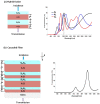All-Dielectric Transreflective Angle-Insensitive Near-Infrared (NIR) Filter
- PMID: 35893505
- PMCID: PMC9370116
- DOI: 10.3390/nano12152537
All-Dielectric Transreflective Angle-Insensitive Near-Infrared (NIR) Filter
Abstract
This paper presents an all-dielectric, cascaded, multilayered, thin-film filter, allowing near-infrared filtration for spectral imaging applications. The proposed design is comprised of only eight layers of amorphous silicon (A-Si) and silicon nitride (Si3N4), successively deposited on a glass substrate. The finite difference time domain (FDTD) simulation results demonstrate a distinct peak in the near-infrared (NIR) region with transmission efficiency up to 70% and a full-width-at-half-maximum (FWHM) of 77 nm. The theoretical results are angle-insensitive up to 60∘ and show polarization insensitivity in the transverse magnetic (TM) and transverse electric (TE) modes. The theoretical response, obtained with the help of spectroscopic ellipsometry (SE), is in good agreement with the experimental result. Likewise, the experimental results for polarization insensitivity and angle invariance of the thin films are in unison with the theoretical results, having an angle invariance up to 50∘.
Keywords: FDTD; NIR filter; angle invariance; spectroscopic ellipsometry; thin films.
Conflict of interest statement
The authors declare no conflict of interest.
Figures












References
-
- Liu J. Smoothing filter-based intensity modulation: A spectral preserve image fusion technique for improving spatial details. Int. J. Remote Sens. 2000;21:3461–3472. doi: 10.1080/014311600750037499. - DOI
-
- Hook S.J., Johnson W.R., Abrams M.J. Thermal Infrared Remote Sensing. Springer; Berlin/Heidelberg, Germany: 2013. NASA’s hyperspectral thermal emission spectrometer (HyTES) pp. 93–115.
Grants and funding
LinkOut - more resources
Full Text Sources
Miscellaneous

